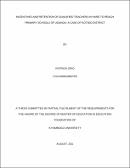| dc.description.abstract | The purpose of this study was to examine the effect of incentives on retention of teachers in hard to reach primary schools of Kotido District. To explain teachers retention, Frederick Herzberg (in Bartol and Martin 1993) building on the identified two elements, Motivators and Hygiene factors. Two Factor theory states that there are certain factors in the work place that can cause job satisfaction while others cause dissatisfaction. As a result, he developed the motivation-hygiene theory to explain these results. Herzberg called the satisfiers motivators and the dissatisfiers as hygiene factors. Correlation design was used where both quantitative and qualitative approaches were adopted. The sample size consisted of 74 respondents which included Teachers, Head teachers, District inspector of schools and District Education Officer. Questionnaire guide, interview guide and observation checklist were used as methods for data collection. Hypotheses were tested using Pearson correlation coefficient and data was also presented using descriptive tables. A Pearson product moment Correlation was run to determine the relationship between financial incentives and teacher retention, then relationship between non financial incentives and teacher retention, finally relationship between working conditions and teacher retention. There was a strong positive correlation between financial incentive and teacher retention. Which was statistically significant (r = 0.724**, N=46 and P=0.000). Therefore the null hypothesis was rejected. Secondly, there was a strong positive correlation between non financial incentive and teacher retention. Which was statistically significant(r = 0.747**, N=46 and P=0.000). The null hypothesis was rejected. Finally there was a strong positive correlation between working conditions and teacher retention which was statistically significant (r = 0.725**, N=46 and P=0.000). The null hypothesis was also rejected. Based on the findings above, it was concluded that incentives contribute to retention of teachers in hard to reach schools and that a change in financial incentives, non financial incentives and working conditions are related to a considerable change in teacher retention where better financial incentives, non financial incentives or working conditions were related to more teacher retention, and vice versa. The study recommended that Educational institutions should act adequately and timely on their financial obligations and provide proper remuneration to teachers if they are to retain their teachers. Schools should treat teachers fairly within the school and in relation to employees of other organizations. They can achieve this by motivating teachers to stay with the school by establishing mechanism to deal with perceived imbalances. Finally working environments of teachers should be well organized to bring balance in their lives by encouraging teachers to relate to all their peers and workmates very well, conducting teacher orientation/induction in their job, facilitating teachers to enjoy their work tasks, guaranteeing teachers` jobs, the school caring for teachers needs appropriately, improving the school disciplinary procedure, and policies so that hard to reach schools retain teachers. | en_US |

